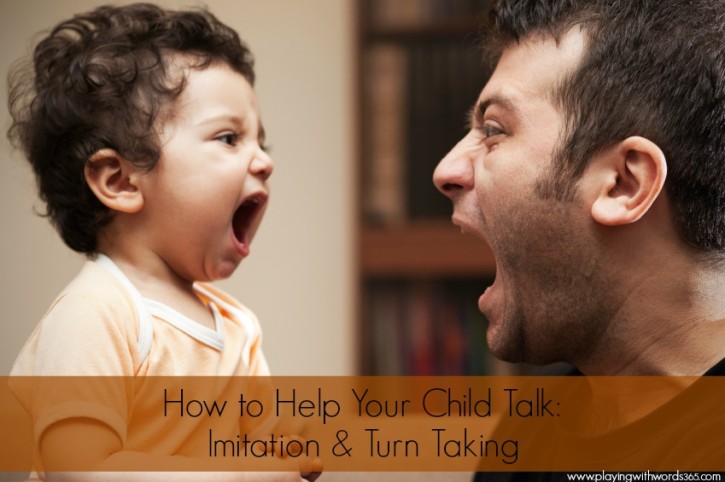Welcome to my How to Help Your Child Talk series. These posts are intended to give you simple tips to help you work with your child so YOU can be your child’s best “speech therapist.†You may want to try out a new tip/strategy for a week or so and then when you feel like you’ve “got it† and it comes more naturally, move on to a new tip and incorporate that into your day for another week or two. For a list of  all my tips, go HERE. This post contains affiliate links to Amazon for your convenience. If you enjoy this series, you may be interested in purchasing my eBook where proceeds are donated to charity. You can read more about my eBook HERE.Â
Communication is a social act that requires turn taking: you say something, your communication partner says something, and you continue taking turns and this makes up a conversation. From a very young age, children learn to take simple turns and imitate what they see and hear. The skills of imitation and turn taking are vital to overall development including speech and language. Children imitate our sounds and words and eventually turn those imitations into language! But what if your child rarely imitates you? Here are some tips.

Decrease the Pressure to Speak
One thing we know from research is decreasing the pressure to speak can actually encourage speech production. Too much pressure to speak can result in a child shutting down and not speaking at all. When working with your young child, you want to avoid the following:
- Phrases like “Billy, say _______!†or “Emma, can you say ______?â€
- The “testing†type questions like “What is this? “ or “What color is that?â€
Provide Opportunities for your Child to Talk and Take a Turn
Rather than asking your child to imitate you or pressuring him to talk, you need to provide natural opportunities for your child to take turns communicating to you. You can do this by using communication temptations and practicing WAITING (see previous sections). When appropriate you can then model language for your child, without the expectation that he repeat you. Make sure that when you take turns playing and communicating that your turns are about the same length as your child’s turns to keep the “conversation†balanced.
Imitate Your Child
If your child is not imitating your words, you want to imitate THEM! This is so important. Imitate their motor movements, their sounds, facial expressions and any words they say. Research indicates that imitating a child’s speech may not only help them learn to imitate but may may trigger the firing of mirror neurons in the brain. In addition, imitating your child models simple verbal turn taking skills that he needs to learn and use within his own communication.
Slow Down and Exaggerate Your Intonation
When speaking to your child speak slowly and exaggerate your intonation. You are soooooooo big!†Make sure to also stress new and important words. “Look at the BIG dog!â€
Sing Songs (and Sing Books Too!)
There is research to support the use of melody and singing to facilitate children’s attempts at speech production. Sing repetitive, fun, and engaging songs to your child often and try reading books that are songs as well! Some favorites include Wheel on the Bus by Raffi, The Itsy Bitsy Spider by Iza Trampani, 5 Little Ducks by Raffi & Down By the Bay by Raffi.
Try Puppet Play
Puppets can be a fantastic tool for decreasing the pressure to speak while also providing naturalistic opportunities for communication. A child may be more willing to interact and respond to a puppet than an adult. Try having your child feed the puppet different foods and non food items (eating silly things is FUN and motivating!). Name the items, talk about them, and make fun noises. Allow time for your child to take turns but do not require it (remember, reduce the pressure to talk!).
For a list of  all my other tips in this series, go HERE.
Looking for more ways to help with your child’s speech and language development? ? I highly recommend these two books: My Toddler Talks: Strategies and Activities to Promote Your Child’s Language Development by fellow SLP and friend Kim Scanlon and It Takes Two To Talk: A Practical Guide For Parents of Children With Language Delays
 from The Hanen Centre.
DISCLAIMER: My tips are for informational purposes only and do NOT replace the interventions of a licensed and certified speech-language pathologist. Please read my full disclaimer and terms of use page for more information.Â
**********************************************************************************************************
References
DeThorne, L.S., Johnson, C.J., Walder, L., & Mahurin-Smith, J. “When Simon Says Doesn’t
Work: Alternatives to Imitation for Facilitating Early Speech Development.†American
    Jouranal of Speech-Language Pathology 18(2009), 133-145.
Pepper, J. & Weitzman, E., (2004). It Takes Two to Talk: A practical guide for parents of children
     with language delays. Toronto, Ontario: Transcontinental Interglobe
Well said, Katie! Thanks for sharing these parent-friendly early language strategies.
Brittany Rickard recently posted..Four Fur Feet